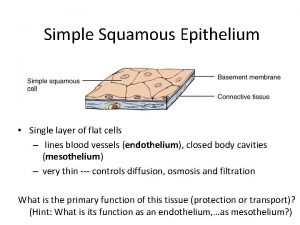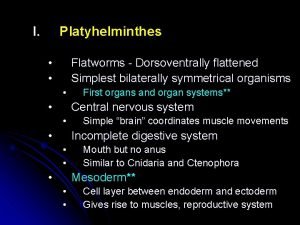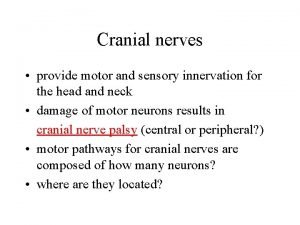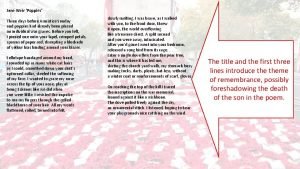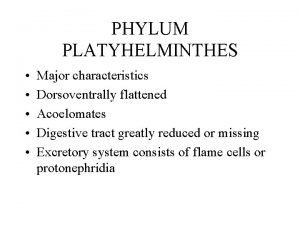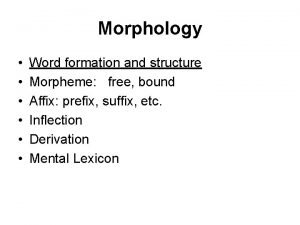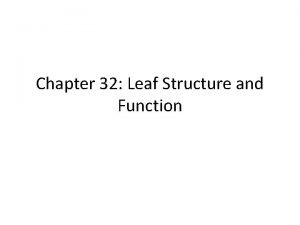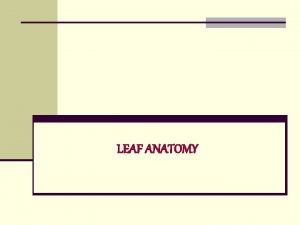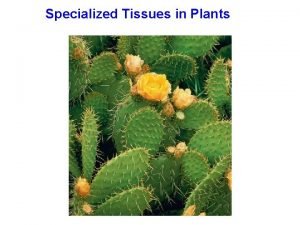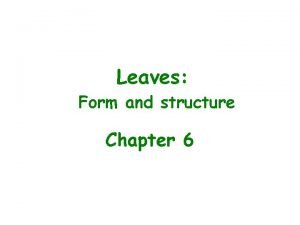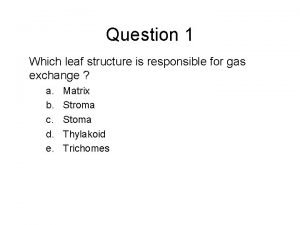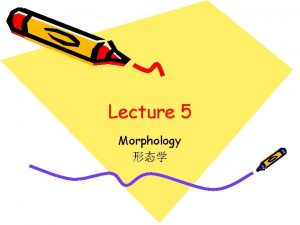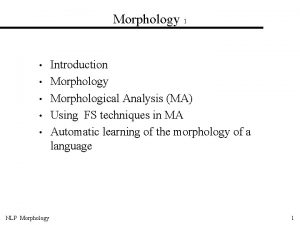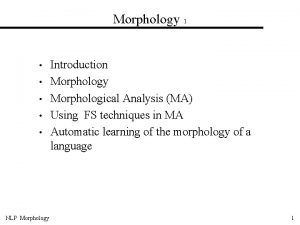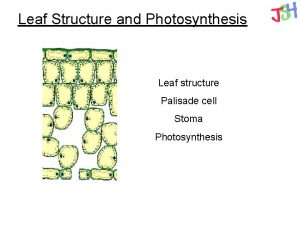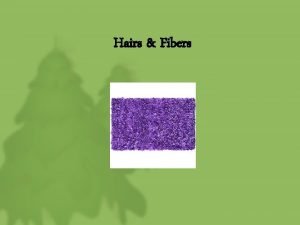LEAF MORPHOLOGY Leaf is a lateral flattened structure
























- Slides: 24

LEAF MORPHOLOGY

• Leaf is a lateral flattened structure borne on the stem. • The leaves develop from the nodes. • Their main function is photosynthesis. • Leaves also carry on respiration. • Another activity of leaves is transpiration. • Some leaves storage water and often food material. • Some leaves are also specialized for many other functions.

Parts of the leaf Most leaves are differentiated into three parts (base, petiole and blade). The base is the lower part of the leaf and the blade is a thin, flat, expanded structure.

Petiole It is stalk-like part which supports the blade and places it in a favorable position to light. There are two types of leaves according to the presence of petiole: 1. Petiolate leaf with a petiole. 2. Sessile leaf: without petiole, blade attached directly to stem.

Petiolate leaf

Sessile leaf

Stipules In many plants, mainly dicotyledons, the leaf may possess one or more commonly, two stipules. A stipule is an outgrowth of the lower zone of a young leaf, part of the leaf base. There are two types of leaves according to their stipules: 1. Exstipulate leaf: have no stipules. 2. Stipulate leaf: with one or more Stipules.

There a number of interesting functions demonstrated for stipules: A. Tendrillar stipules: stipules are modified into tendrils which help plants in climbing (e. g. , Smilax). B. Spinous stipules: stipules are modified into hard spines which prevent the plants from being eaten by animals (e. g. , Mimosa) C. Foliaceous stipules: these are large leaf-like stipules which synthesize food material (e. g. , Pisum, Lathyrus). D. Hairy stipules: these are hair-like or filamentous (e. g. , Corchorus) E. Adnate stipules: these attach themselves to the petiole for a short distance by their inner margins (e. g. , Rosa).


Leaf arrangement on a stem There are three basic types of leaf arrangement: ❖ Alternate leaves are arranged in an alternating pattern on the stem (one leaf at each node). ❖ opposite leaves are attached to the stem across from each other (two leaves at each node). ❖ Whorled leaves are arranged in circles around the stem


Simple and Compound Leaves 1 - Simple leaf: lamina (leaf blade) is not split up into distinct leaflets. It may be entire as in Mango or lobed as in Cotton. 2 - Compound leaf: lamina is split into a number of separate parts called leaflets. Leaflets resemble in many respects simple leaves. An axillary bud is present in the axil of a simple or a compound leaf, but it does not occur in the axil of the leaflet of a compound leaf.

• There are two types of compound leaves, namely, pinnate and palmate. • The leaflets in pinnately compound leaves arise from either side of an axis called the rachis. • Each leaflet is known as a pinna. • If the pinnae are divided the secondary divisions are known as pinnules and the leaf is known as bipinnate leaf. • When the pinnate leaf terminates with a single leaflet it is called is imparipinnate (odd pinnate) leaf. • Paripinnate (even pinnate) leaf is a pinnately leaf with pair terminal leaflets.


• • • The leaflets in palmately compound leaves originate at the tip of the petiole and lack the rachis. When two leaflets arise from the tip of petiole it is called bifoliate. Trifoliate leaves have leaflets arranged in threes.

The compound leaf often is mistaken for a stem bearing leaves. The following points help in differentiation: 1. Compound leaf has no apical bud. 2. It has a bud in its axil and does not arise in the axil of a leaf

Venation is the system of veins that extends from the petiole to all parts of the blade. The veins are extensions of the vascular system of the stem. They serve in the transport of water and dissolved substances that pass into and out of the leaf. Leaves display two types of venation:

1 - Reticulate (net) venation: The veins form an easily recognizable network. Larger veins giving rise to smaller and smaller branches that finally end freely in the green tissue. There are two types namely, pinnate and palmate. Net-veined leaves are found principally among the dicotyledons.


2 - Parallel venation: The veins run parallel to one another. Veins are approximately of the same size and do not form a network. They occur chiefly among the monocotyledons. There are two types of parallel venation: a. Longitudinal venation: Veins run generally from the base through the blade to the apex (wheat, Zea mays). b. Transverse venation: Veins run from a central strand of veins to the blade margin (canna, banana)

Lamina (blade) shape The form of the leaf blade is constant for a particular species and varies for different plants. The different forms are described by various terms such as: Acicular: needle shaped (Pinus) Tubular: hollow tube (Allium cepa) Linear: elongate shape (grasses) Lanceolate: elongated, gradually tapering towards base and apex (Salix) • Ovate: oval shape (Ficus bengalensis) • Cordate: heart-shaped with point end at the apex • • (Ipomea)

• Sagittate: arrow shape with the basal lobes downwards (Polygonum) • Spathulate: A spoon-shaped, has a rounded top and a tapering base • Peltate: round and the petiole emerge from the lower surface and not from the base of lamina (Tropaeolum). • Deltoid: triangular in outline, suggesting a capital delta. • Oblong: elongated, non-lobed leaf, long is twice as wide

• Reniform: leaf blade is shaped like a kidney • Elliptical: A narrow oval, it is boarder in center than ends. • Obovate: An egg-shaped blade, broader at the top than the base. • Hastate: An arrow-shaped leaf with lobes that point outward.

 Inflectional and derivational morphology
Inflectional and derivational morphology Economic importance of leaves
Economic importance of leaves Maple leaf and oak leaf homologous
Maple leaf and oak leaf homologous Leaf and non leaf procedure
Leaf and non leaf procedure What's lateral surface area
What's lateral surface area Flattened diaphragm
Flattened diaphragm Single layer of rectangular cells
Single layer of rectangular cells Ober test
Ober test Increased retrosternal space
Increased retrosternal space Platyhelminthes dorsoventrally flattened
Platyhelminthes dorsoventrally flattened Nasolabial fold flattening
Nasolabial fold flattening Sellotape bandaged
Sellotape bandaged Fasciola hepatica acoelomate
Fasciola hepatica acoelomate 20-50 rows of flattened cells
20-50 rows of flattened cells ро
ро Pseudostratified vs simple columnar
Pseudostratified vs simple columnar Amaze word formation
Amaze word formation Examples of morphology in language
Examples of morphology in language Morphology the study of word structure
Morphology the study of word structure Internal structure of leaf
Internal structure of leaf Upper epidermis function in photosynthesis
Upper epidermis function in photosynthesis Leaf anatomy
Leaf anatomy Root structure
Root structure Guard cells in plants
Guard cells in plants Leaf structure questions
Leaf structure questions






